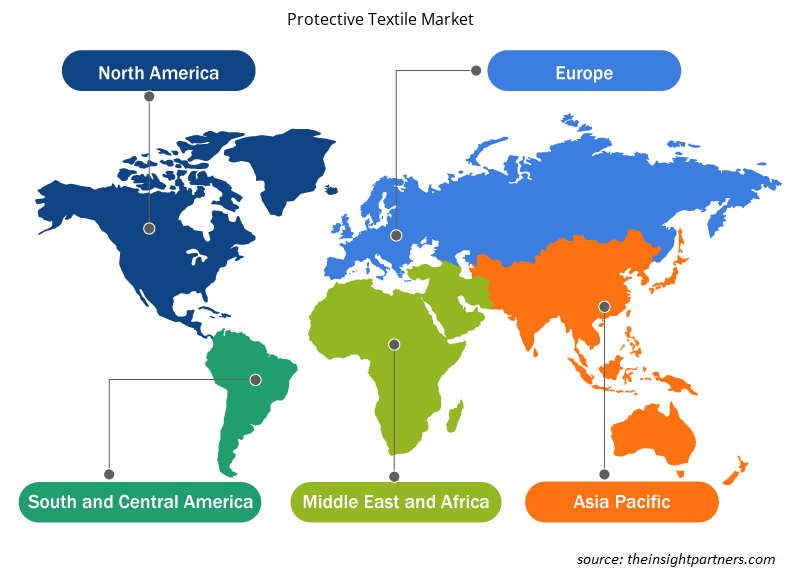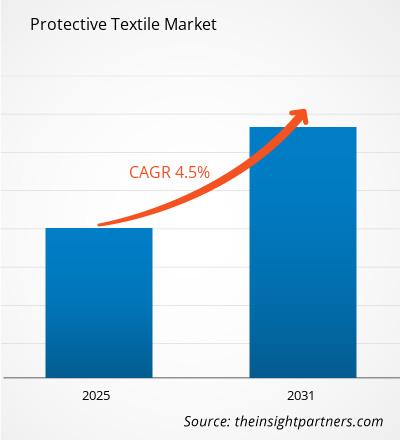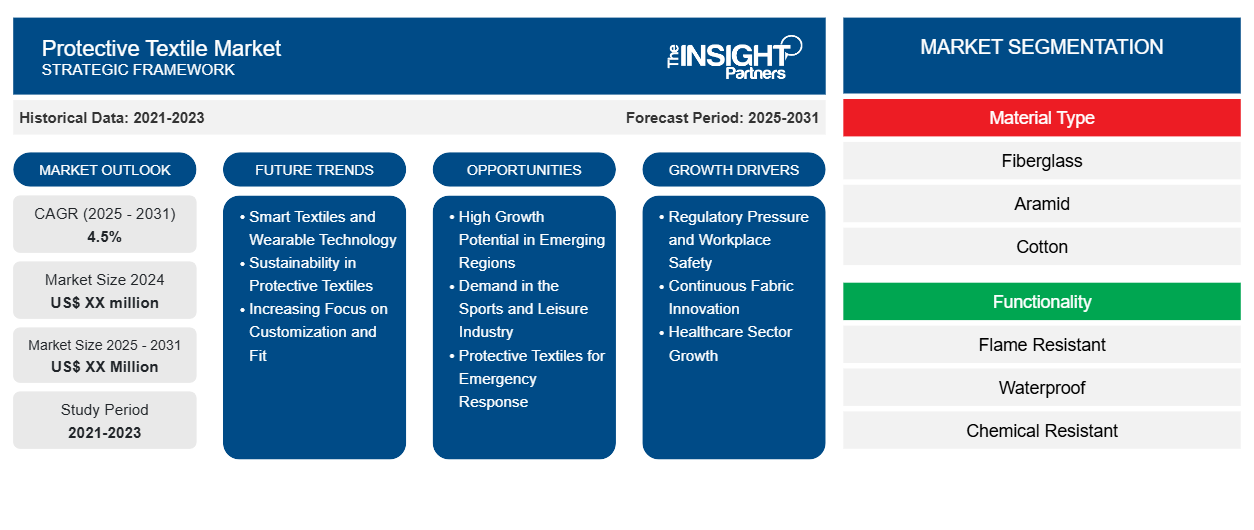Se espera que el mercado de textiles protectores registre una CAGR del 4,5 % entre 2024 y 2031, con un tamaño de mercado que se expandirá de US$ XX millones en 2024 a US$ XX millones en 2031.
El informe está segmentado por tipo de material (fibra de vidrio, aramida , algodón, poliéster, materiales compuestos y otros). El informe está segmentado por funcionalidad (resistente al fuego, impermeable, resistente a los productos químicos y otros). El informe presenta además un análisis basado en el uso final (petróleo y gas, construcción, fabricación, atención médica, militar y otros). El alcance del informe cubre cinco regiones: América del Norte, Europa, Asia Pacífico, Medio Oriente y África, y América del Sur y Central y los países clave de cada región. El análisis global se desglosa aún más a nivel regional y por países principales. El informe ofrece el valor en USD para el análisis y los segmentos anteriores.
Propósito del Informe
El informe Mercado de textiles de protección de The Insight Partners tiene como objetivo describir el panorama actual y el crecimiento futuro, los principales factores impulsores, los desafíos y las oportunidades. Esto proporcionará información a diversas partes interesadas del negocio, como:
- Proveedores/fabricantes de tecnología: Para comprender la dinámica cambiante del mercado y conocer las oportunidades potenciales de crecimiento, lo que les permitirá tomar decisiones estratégicas informadas.
- Inversionistas: Realizar un análisis exhaustivo de tendencias sobre la tasa de crecimiento del mercado, las proyecciones financieras del mercado y las oportunidades que existen en toda la cadena de valor.
- Órganos reguladores: Regular las políticas y vigilar las actividades del mercado con el objetivo de minimizar los abusos, preservar la confianza de los inversores y defender la integridad y la estabilidad del mercado.
Segmentación del mercado de textiles de protección
Tipo de material
- Fibra de vidrio
- Aramida
- Algodón
- Poliéster
- Materiales compuestos
Funcionalidad
- Resistente al fuego
- Impermeable
- Resistente a químicos
Uso final
- Petróleo y gas
- Construcción
- Fabricación
- Cuidado de la salud
- Militar
Geografía
- América del norte
- Europa
- Asia-Pacífico
- América del Sur y Central
- Oriente Medio y África
Personalice este informe según sus necesidades
Obtendrá personalización en cualquier informe, sin cargo, incluidas partes de este informe o análisis a nivel de país, paquete de datos de Excel, así como también grandes ofertas y descuentos para empresas emergentes y universidades.
- Obtenga las principales tendencias clave del mercado de este informe.Esta muestra GRATUITA incluirá análisis de datos, desde tendencias del mercado hasta estimaciones y pronósticos.
Factores impulsores del crecimiento del mercado de textiles de protección
- Presión regulatoria y seguridad en el lugar de trabajo: El creciente interés en la seguridad en el lugar de trabajo y la inclusión de regulaciones de seguridad más estrictas impulsan el mercado de textiles de protección. Las industrias manufactureras, de atención médica, de construcción y mineras necesitan proporcionar ropa de protección para sus empleados para prevenir lesiones y mantener la seguridad. Por lo tanto, la protección de los tejidos textiles contra el calor, los productos químicos, los cortes y otras amenazas está impulsada por la demanda de regulación de grupos como la Administración de Seguridad y Salud Ocupacional de los EE. UU. y otros en otras partes del mundo. Esta presión regulatoria ha dado como resultado textiles de protección y las empresas han ideado varias soluciones para la seguridad estándar.
- Innovación continua en tejidos: La innovación continua en la tecnología de los tejidos, como las fibras resistentes al fuego, los revestimientos de alto rendimiento y los tejidos antibacterianos, se aplica cada vez más a los textiles de protección. Por ejemplo, las personas utilizan con mayor frecuencia fundas textiles transpirables y protectoras contra temperaturas extremas o sustancias peligrosas. Estas innovaciones hacen que la ropa de protección sea duradera y cómoda, por lo que es posible satisfacer todos los diversos requisitos de las diferentes industrias. Los nuevos materiales y procesos introducidos con el tiempo beneficiarán al mercado.
- Crecimiento del sector sanitario: la demanda de textiles de protección ha aumentado en la industria sanitaria, especialmente debido a la pandemia de COVID-19. Existe una mayor demanda de equipos de protección personal, como batas, mascarillas, guantes y paños quirúrgicos. Los textiles que combinan protección microbiana con comodidad son buscados en hospitales, clínicas y laboratorios. El crecimiento de las infraestructuras sanitarias con un mayor énfasis en el control de infecciones y la higiene está aumentando la demanda de textiles de protección de grado médico.
Tendencias futuras del mercado de textiles de protección
- Textiles inteligentes y tecnología portátil: una de las tendencias que se notará más será la relacionada con la ropa de protección relacionada con los textiles inteligentes. Se trata de tejidos con sensores o materiales conductores que tienen la capacidad de monitorizar las condiciones ambientales como la temperatura, la presión o incluso los valores de salud de un cuerpo como los latidos del corazón o la temperatura corporal. Su adopción es masiva, principalmente debido a que se encuentran en sectores industriales como la defensa, los deportes y la atención sanitaria. Las industrias necesitan monitorizar a los trabajadores en tiempo real. Por ejemplo, los soldados en el servicio militar utilizan trajes inteligentes que pueden detectar la presencia de peligros biológicos o cambios en su salud.
- Sostenibilidad en los textiles de protección: Hoy en día, la producción y el procesamiento de los textiles de protección dependen del creciente factor medioambiental. Los científicos medioambientales están instando a los productores a formular materiales que consuman menos recursos, que sean reciclables o biodegradables para su producción. Hoy en día, se puede ver una oferta abundante de ropa de protección que utiliza la nueva variedad de fibras de origen biológico: cáñamo, algodón y fibras sintéticas recicladas. El aumento de la demanda de productos respetuosos con el medio ambiente por parte de los consumidores y la presión regulatoria contra la industria textil para reducir sus impactos negativos en el medio ambiente también están impulsando la tendencia hacia la sostenibilidad.
- Enfoque creciente en la personalización y el ajuste: una tendencia importante en los textiles de protección en la actualidad es la personalización para satisfacer las necesidades específicas de los usuarios. La industria quiere que sus empleados tengan ropa resistente al fuego que se ajuste a su tamaño corporal o EPI diseñados para condiciones ambientales específicas, ya sea frío o calor extremos. Las mejoras en las tecnologías de tejido y tejido en 3D facilitan esta tendencia y brindan más comodidad con un mejor ajuste, al tiempo que ofrecen una mejor protección.
Oportunidades de mercado en textiles de protección
- Alto potencial de crecimiento en regiones emergentes: Las regiones de Asia-Pacífico, América Latina y África se consideran áreas con alto potencial de crecimiento para el mercado de textiles de protección. La creciente industrialización, urbanización y desarrollo de la infraestructura de atención médica crean una demanda cada vez mayor de EPP y ropa de protección. Las empresas pueden aprovechar esta tendencia ofreciendo nuevos productos en estos mercados a medida que los países invierten más en seguridad industrial y atención médica.
- Demanda en la industria del deporte y el ocio: la demanda de textiles protectores en la industria del deporte y el ocio está aumentando, ya que los atletas necesitan ropa especializada para protegerse en actividades de alto riesgo. Por ejemplo, el ciclismo, el esquí y los deportes de motor necesitan textiles resistentes a los impactos, que regulen la temperatura y que absorban la humedad. Como resultado de la creciente popularidad de las actividades recreativas en todo el mundo, los fabricantes pueden sacar provecho de este segmento con equipos de protección orientados al rendimiento.
- Textiles protectores para la respuesta a emergencias: También hay más casos de desastres naturales como incendios forestales, inundaciones y huracanes que aumentan aún más la necesidad de textiles protectores para la respuesta a emergencias. Los EPI con requisitos de protección específicos contra ciertas amenazas ambientales están en aumento, especialmente los resistentes al fuego para su uso por parte de los bomberos forestales o los resistentes al agua y al calor en áreas propensas a inundaciones. El potencial de desarrollar productos textiles para estas nuevas formas de peligros relacionados con el clima es enorme.
Perspectivas regionales del mercado de textiles de protección
Los analistas de Insight Partners explicaron en detalle las tendencias y los factores regionales que influyen en el mercado de textiles de protección durante el período de pronóstico. Esta sección también analiza los segmentos y la geografía del mercado de textiles de protección en América del Norte, Europa, Asia Pacífico, Oriente Medio y África, y América del Sur y Central.

- Obtenga los datos regionales específicos para el mercado de textiles de protección
Alcance del informe sobre el mercado de textiles protectores
| Atributo del informe | Detalles |
|---|---|
| Tamaño del mercado en 2024 | XX millones de dólares estadounidenses |
| Tamaño del mercado en 2031 | US$ XX millones |
| CAGR global (2025 - 2031) | 4,5% |
| Datos históricos | 2021-2023 |
| Período de pronóstico | 2025-2031 |
| Segmentos cubiertos | Por tipo de material
|
| Regiones y países cubiertos | América del norte
|
| Líderes del mercado y perfiles de empresas clave |
|
Densidad de actores del mercado de textiles de protección: comprensión de su impacto en la dinámica empresarial
El mercado de textiles de protección está creciendo rápidamente, impulsado por la creciente demanda de los usuarios finales debido a factores como la evolución de las preferencias de los consumidores, los avances tecnológicos y una mayor conciencia de los beneficios del producto. A medida que aumenta la demanda, las empresas amplían sus ofertas, innovan para satisfacer las necesidades de los consumidores y aprovechan las tendencias emergentes, lo que impulsa aún más el crecimiento del mercado.
La densidad de actores del mercado se refiere a la distribución de las empresas o firmas que operan dentro de un mercado o industria en particular. Indica cuántos competidores (actores del mercado) están presentes en un espacio de mercado determinado en relación con su tamaño o valor total de mercado.
Las principales empresas que operan en el mercado de textiles de protección son:
- 3M
- Cetriko, SL
- Compañía Glen Raven, Inc.
- Klopman Internacional,
- Industrias Kolon Inc.
Descargo de responsabilidad : Las empresas enumeradas anteriormente no están clasificadas en ningún orden particular.

- Obtenga una descripción general de los principales actores clave del mercado de textiles protectores
Puntos de venta clave
- Cobertura integral: el informe cubre de manera integral el análisis de productos, servicios, tipos y usuarios finales del mercado de textiles protectores, proporcionando un panorama holístico.
- Análisis de expertos: el informe se compila sobre la base de un profundo conocimiento de expertos y analistas de la industria.
- Información actualizada: El informe asegura relevancia comercial debido a su cobertura de información reciente y tendencias de datos.
- Opciones de personalización: este informe se puede personalizar para satisfacer los requisitos específicos del cliente y adaptarse adecuadamente a las estrategias comerciales.
Por lo tanto, el informe de investigación sobre el mercado de textiles de protección puede ayudar a abrir camino para descifrar y comprender el escenario de la industria y las perspectivas de crecimiento. Si bien puede haber algunas preocupaciones válidas, los beneficios generales de este informe tienden a superar las desventajas.
- Análisis histórico (2 años), año base, pronóstico (7 años) con CAGR
- Análisis PEST y FODA
- Tamaño del mercado, valor/volumen: global, regional y nacional
- Industria y panorama competitivo
- Conjunto de datos de Excel
Informes recientes
Testimonios
Razón para comprar
- Toma de decisiones informada
- Comprensión de la dinámica del mercado
- Análisis competitivo
- Información sobre clientes
- Pronósticos del mercado
- Mitigación de riesgos
- Planificación estratégica
- Justificación de la inversión
- Identificación de mercados emergentes
- Mejora de las estrategias de marketing
- Impulso de la eficiencia operativa
- Alineación con las tendencias regulatorias





















 Obtenga una muestra gratuita para - Mercado de textiles de protección
Obtenga una muestra gratuita para - Mercado de textiles de protección